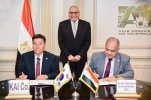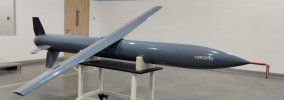Cooperation and partnership agreement
Between the Arab Organization for Industrialization and Korea Aerospace Industries
Ali localization of advanced training aircraft manufacturing technology
Major General A. H. Engineer "Mokhtar Abdel Latif", Chairman of the Arab Organization for Industrialization, stressed the importance of cooperation and partnership with international expertise, in implementation of the directives of President "Abdel Fattah El-Sisi" on the importance of localizing technology and increasing the proportions of the local component and added value in various defense industries.
This cameduring the signing of the cooperation agreement between the Arab Organization for Industrialization and the Korea Aerospace and Aerospace Industries Corporation (KAAI), which is one of the largest South Korean companies specialized in aerospace manufacturing technology.
In this regard, the President of the Arab Organization for Industrialization expressed his pride in the importance of this cooperation and partnership with the company ((KAI), pointing out that it was agreed to localize the technology of manufacturing an advanced training aircraft to meet the needs of the armed forces, and export to African and Arab countries, by taking advantage of the advanced production capacities in the aircraft factory of the Arab Organization for Industrialization.
He added that the areas of cooperation include the exchange of experiences and the training of human cadres in the authority on manufacturing and maintenance work according to the latest digital manufacturing systems, expressing the aspiration of the Arab Organization for Industrialization to open new areas of cooperation in various advanced defense industries, through a coordinating committee between the two sides to follow up the implementation of joint projects.
For his part, Mr. Kang Wong Sik, Advisor to the Chairman of the Board of Directors of Korea Aerospace and Aerospace Industries Company, expressed his pride in the importance of cooperation with the Arab Organization for Industrialization, the industrial backer of the Egyptian state and its expertise in various manufacturing and human capabilities in accordance with international quality systems in various industries, stressing that the Egyptian market is attractive for investments and promising and constitutes a strategic importance for the countries of the African and Arab region.
He added that KAI is looking forward to strengthening aspects of partnership with Arab Industrialization in many other defense industries.
This news is a general framework for an agreement, not an agreement or Korea winning the tender for the Egyptian advanced training aircraft. Rather, it is a prelude in the event that the Korean T-50 plane wins.
Therefore, the same agreement will be signed with the Indian company HAL in favor of the LCA-MK1A aircraft
Also, the agreement is related to another additional training aircraft, perhaps an upgraded version of the Korean KT-1 plane, or even the new Korean design for an electric motor-powered plane.
We come to the most important points related to the LCA TEJAS aircraft
The news inside India talks about providing alternatives to the Israeli radar and the American engine, which it is believed that there is no problem with Egypt obtaining it from the Indian point of view, but from the Egyptian side, the problem may be the desire to obtain the quantities that Egypt requires without restrictions, as well as copies that can be developed, away from American pressures and restrictions We will present the Indian point of view and the most prominent development in these points
""
According to recent media reports India has invited Egyptian President Abdel Fattah El-Sisi a military General turned politician as Chief Guest for the 2023 Republic Day parade, this would be the first time an Egyptian President would be the chief guest at India's Republic Day Parade.
New Delhi has extended this invitation to Cairo as it wishes to expand upon Indo-Egyptian economic and defense ties and is exploring a sale of 70 Tejas Mk1A Light Combat Aircraft to Cairo as the latter is looking for a replacement for its aging fleet of Mirage F5s with a focus on local manufacturing and technology transfer and the Republic day parade would be a great opportunity for the Indian military-industrial complex to showcase its abilities in front of the Egyptian leader.
Tejas Mk1A is a single-engine tailless compound delta wing light multi-role fighter designed by the Aeronautical Development Agency (ADA) and manufactured by Hindustan Aeronautics Limited (HAL) intended as a replacement for India's aging fleet of Mig-21s.
It has a Length of 13.2 m, a Wingspan of 8.2 m, and a Height of 4.4 m with an empty weight of 6560 kg and a maximum takeoff weight of 13500 kg.
Powered by a single General Electric F404-GE-IN20 afterburning turbofan Engine it can fly at a maximum speed of Mach 1.6 and can carry a total weight of 5300 kg on its 8 external hard points and with an internal fuel capacity of 2500 kg, it has an effective combat range of nearly 750 km.
Cairo has tried to diversify its portfolio of aircraft to prevent its air force from being rendered useless in case it ever gets hit by western sanctions. This sentiment has only grown stronger after the partial arms embargo imposed by the EU and USA after the 2013 coup.
It is for this reason that EAF is so adamant about an aircraft with no strings attached, local manufacturing, and some degree of technology transfer so that its aircraft can keep on flying even in the heat of the sanctions
The Egyptian Air force operates a mix of American, French, soviet, and Chinese aircraft, Indian HAL Tejas Mk1A will add an extra layer of depth to this diverse mix bag of aircraft.
The Indian offer seems to fulfill all these conditions as the Tejas manufacturer Hindustan Aeronautics Limited (HAL) has offered to establish a production line and some degree of ToT along with a repair and overhaul facility if it wins the deal.
India's no strings attached policy regarding its weapons usage along with the diverse set of weapons package Tejas can fire such as the Soviet R73, R77, KH59, KH35 French MICA, AASM American GBUs, and Indian Astra 1/2/3, SAAW, Bramhos (world's fastest supersonic cruise missile), Rudram 1/2/3, etc makes Tejas even more attractive as EAF already operates many of these weapons.
However, it's not all sunshine and roses for Tejas either. Tejas has a fairly high amount of imported subsystems present in it, 25% to be exact most notable of which are the Israeli Elta EL/M 2052 AESA Radar, DASH Helmet Mounted Display, British Martin Baker Mk16 Ejection seats, and American General Electric F404-GE-IN20 afterburning turbofan engine, presence of these imported subsystems makes it susceptible to western sanctions, also given the tense relations between Egypt and Israel a deal with Israeli subsystems present on Tejas is highly unlikely, However, it should be noted that HAL is trying to replace these imported subsystems with homegrown alternatives such as the Uttam AESA radar to replace the current Israeli Elta EL/M 2052 AESA Radar, etc.
Other imported subsystems such as the Martin Baker Ejection seats, and General Electric F404-GE-IN20 afterburning turbofan engine shouldn't be too much of a problem since EAF already operates a large number of them making logistics easier, furthermore such strict western sanctions are highly unlikely in the recent future.
The reluctance shown by the IAF in inducting Tejas in its early days and its low order amount gives Tejas a bad rep.
The Main competitor against the Tejas would be the Korean FA-50 a light combat aircraft developed by Korea Aerospace Industries (KAI) and Lockheed Martin an American aerospace giant
Technologically speaking both the Tejas and the FA-50 are quite similar and even face the same difficulties in this competition for example both have a high amount of imported subsystems, however, FA-50 has more imported subsystems than the Tejas such as Israeli Radar, EW suite, helmet mounted display American Engine, avionics, weapons, etc.
Apart from that unlike Hindustan Aeronautics Limited (HAL) Korea Aerospace Industries (KAI) is unwilling to offer local manufacturing or any useful amount of technology transfer.
However, one field FA-50 excels in comparison to Tejas is its high export success because as of right now at least 5 countries are using the FA-50 whereas Tejas is only used by India ""
Old news for
Uttam AESA Mk2 Radar for lca Tejas MK 2
Uttam AESA Mk2 Radar for lca Tejas MK 2 - 2021
Just for the comparison, the Tejas Mk2 will have a radar with more TRM than RBE2 of Rafale fighter jet. Baseline Uttam AESA – 736 TR modules RBE2 of Rafale – 838 – 1100 TR modules (based on the variant) AN/APG-68 offered on F21 – Around 1000 TR modules Uttam MK2 – 912 – 968 TR modules Though the range and the ability to track the stealthy targets is not limited to number of TR modules, there are numerous other factors involved. 912-968 TR modules is an impressive number.
updated news for uttam radar for Tejas MK1A
https://idrw.org/tejas-mk1a-to-get-uttam-fcr-with-higher-trm-than-originally-planned/
Tejas Mk1A to get Uttam FCR with Higher TRM than Originally Planned
Published November 24, 2022 | By
admin
DRDO’s LRDE at “DefEXpo 2022” that had showcased the Uttam AESA (Active Electronically Scanned Array) Fire Control Radar (FCR) with a 912 TR module and it was confirmed it was an upgraded variant of the Uttam AESA FCR. DRDO-HAL originally planned to incorporate Uttam FCR with 780 TR modules from 21st Tejas Mk1A but now the plan might be changed to incorporate upgraded FCR with 912 TR but it might be seen from later batches.
ELM 2052 Radar that HAL has locally manufactured in collaboration with Israeli ELTA under the Transfer of Technology deal might be procured more than 20 units for the Tejas Mk1A and later units will come with Uttam FCR with 912 TR modules.
Upgraded Uttam Mk2 that was developed for the Tejas MkII program might also find its way now into Tejas Mk1A to streamline the production line as Tejas Mk1A also has a larger Nose cone it can accommodate in it.






